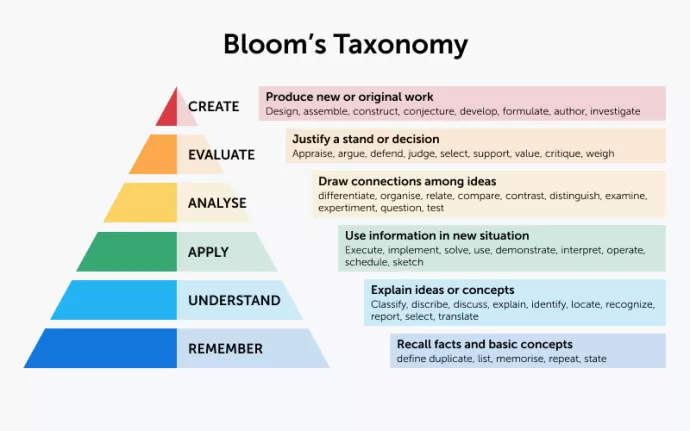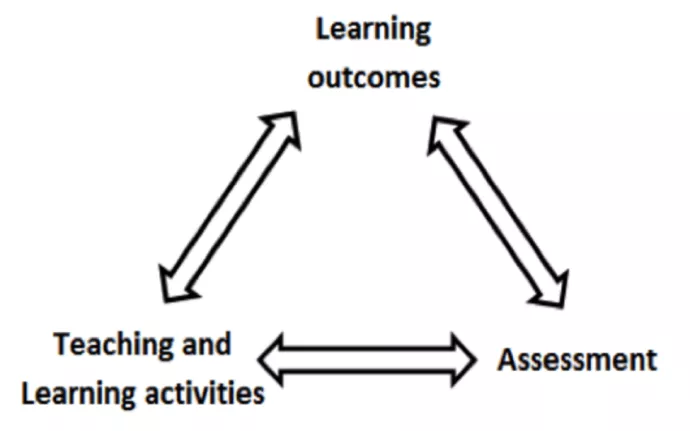Learning outcomes should drive assessment by helping to answer the question: What should students know or demonstrate by the end of the course? To begin the process of creating learning outcomes and connecting them to assessments, ask yourself: What concepts, skills, and values from the course should students be able to understand, retain, and apply in their continuing studies or lives more generally? Those 3-4 concepts, skills, and/or values should be at the heart of your learning outcomes and your assessments are where learners demonstrate that they have attained the learning outcomes. The verbs used in your learning outcomes point to appropriate modes of assessment.
A helpful way to identify and express different learning outcomes in your courses is to draw from the various verbs that are associated with Bloom’s taxonomy of learning. Bloom's Taxonomy (1956; revised by Anderson & Krathwohl in 2001) provides a hierarchically arranged framework for thinking about learning that is comprised of six-levels: remember, understand, apply, analyze, evaluate, and create. Each level builds on the ones before it. For example before a student can apply a concept, they must be able to remember and understand it. What is more, each of these levels correspond to numerous verbs that provide a helpful means of organizing and breaking down the various possible learning outcomes in your courses. For example, the verbs “recognize,” “recall,” and “match” are all verbs associated with the lowest level of the taxonomy, “remember” (see here for a CTSI resource that lists various verbs that correspond to each level).

The learning outcomes that you create should directly inform your assignments and other assessments. Consider the following learning outcome: “By the end of this course, students will be able to recognize the major factors that influenced the development of the Canadian political system.” In this learning outcome, the verb “recognize” indicates that a lower level of cognition is expected; it is associated with remember (the lowest level) in Bloom’s Taxonomy. The verb used in the learning outcome establishes what learning activities and assessments can be used to demonstrate that the learning outcome has been achieved. For example, the learning outcome above might be assessed through a multiple choice or true/false question on a midterm. By contrast, a learning outcome that asks students to evaluate how effective different policy tools are at reducing global energy consumption, might be assessed through a policy brief assignment or a group project that asks students to engage in a debate focused on carbon taxing as a tool for reducing greenhouse gas emissions. In this way, assignments and assessments provide measurable evidence for student achievement of your learning outcomes.
What tools can I use to help me align my learning outcomes and assessments?

Alignment in course design is often depicted using a triangle to show how learning outcomes, assessments, and activities should all be connected to and support one another. Learning outcomes and assessments are described above. Learning activities help support learning outcomes and assessments by introducing students to the concepts and the thought processes needed to complete the assessments. In the example below, students have an opportunity to practice evaluating two policy tools, carbon taxing and cap-and-trade, by participating in a think-pair-share activity before they are assessed during a policy debate. A 3-column table, like the one below, can be a helpful tool for ensuring that the learning outcomes, assessments, and activities for your course are aligned.
|
Learning outcomes |
Learning Activities |
Assessments |
|
By the end of this course, students will be able to evaluate how effective different policy tools are at reducing global energy consumption. |
A think-pair-share activity that asks students whether carbon taxing or cap-and-trade is more effective at reducing greenhouse gas emissions. |
In teams, students engage in a policy debate in which they advocate for or against carbon taxing as a tool to help greenhouse gas emissions. |
Resources
Anderson, L. W., & Krathwohl, D. R. (2001). A Taxonomy for Learning, Teaching and Assessing: A Revision of Bloom’s Taxonomy of Educational Objectives: Complete Edition. New York: Longman.
Biggs, J. B. & Tang, C. (2011). Teaching for quality learning at university (3rd Ed). Maidenhead: Open University Press.
Centre for Teaching Support and Innovation. (2015). Writing Learning Outcomes using Bloom’s Revised Taxonomy. Toronto, ON: Centre for Teaching Support and Innovation at the University of Toronto. Retrieved from https://teaching.utoronto.ca/wp-content/uploads/2015/08/Learning-Outcomes-Using-Blooms-Taxonomy.pdf
Centre for Teaching Support and Innovation. (n.d.) Appendix C: Taxonomies of Educational Objectives. https://teaching.utoronto.ca/teaching-support/course-design/developing-learning-outcomes/appendix-c-taxonomies-of-educational-objectives/
Fink, D.L. (2013). Creating significant learning experiences: an integrated approach to designing college courses. San Francisco, CA: Jossey-Bass.
